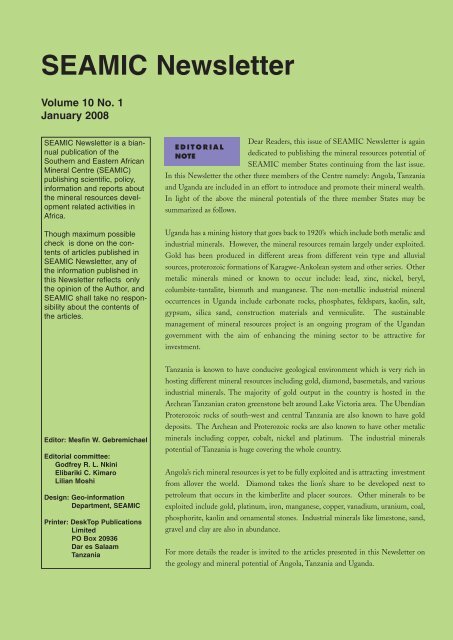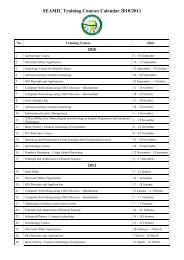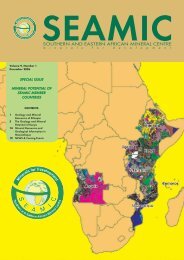SEAMIC Newsletter Vol. 10
SEAMIC Newsletter Vol. 10
SEAMIC Newsletter Vol. 10
Create successful ePaper yourself
Turn your PDF publications into a flip-book with our unique Google optimized e-Paper software.
<strong>SEAMIC</strong> <strong>Newsletter</strong><br />
<strong>Vol</strong>ume <strong>10</strong> No. 1<br />
January 2008<br />
<strong>SEAMIC</strong> <strong>Newsletter</strong> is a biannual<br />
publication of the<br />
Southern and Eastern African<br />
Mineral Centre (<strong>SEAMIC</strong>)<br />
publishing scientific, policy,<br />
information and reports about<br />
the mineral resources development<br />
related activities in<br />
Africa.<br />
Though maximum possible<br />
check is done on the contents<br />
of articles published in<br />
<strong>SEAMIC</strong> <strong>Newsletter</strong>, any of<br />
the information published in<br />
this <strong>Newsletter</strong> reflects only<br />
the opinion of the Author, and<br />
<strong>SEAMIC</strong> shall take no responsibility<br />
about the contents of<br />
the articles.<br />
Dear Readers, this issue of <strong>SEAMIC</strong> <strong>Newsletter</strong> is again<br />
EDITORIAL<br />
NOTE<br />
dedicated to publishing the mineral resources potential of<br />
<strong>SEAMIC</strong> member States continuing from the last issue.<br />
In this <strong>Newsletter</strong> the other three members of the Centre namely: Angola, Tanzania<br />
and Uganda are included in an effort to introduce and promote their mineral wealth.<br />
In light of the above the mineral potentials of the three member States may be<br />
summarized as follows.<br />
Uganda has a mining history that goes back to 1920’s which include both metalic and<br />
industrial minerals. However, the mineral resources remain largely under exploited.<br />
Gold has been produced in different areas from different vein type and alluvial<br />
sources, proterozoic formations of Karagwe-Ankolean system and other series. Other<br />
metalic minerals mined or known to occur include: lead, zinc, nickel, beryl,<br />
columbite-tantalite, bismuth and manganese. The non-metallic industrial mineral<br />
occurrences in Uganda include carbonate rocks, phosphates, feldspars, kaolin, salt,<br />
gypsum, silica sand, construction materials and vermiculite. The sustainable<br />
management of mineral resources project is an ongoing program of the Ugandan<br />
government with the aim of enhancing the mining sector to be attractive for<br />
investment.<br />
Editor: Mesfin W. Gebremichael<br />
Editorial committee:<br />
Godfrey R. L. Nkini<br />
Elibariki C. Kimaro<br />
Lilian Moshi<br />
Design: Geo-information<br />
Department, <strong>SEAMIC</strong><br />
Printer: DeskTop Publications<br />
Limited<br />
PO Box 20936<br />
Dar es Salaam<br />
Tanzania<br />
Tanzania is known to have conducive geological environment which is very rich in<br />
hosting different mineral resources including gold, diamond, basemetals, and various<br />
industrial minerals. The majority of gold output in the country is hosted in the<br />
Archean Tanzanian craton greenstone belt around Lake Victoria area. The Ubendian<br />
Proterozoic rocks of south-west and central Tanzania are also known to have gold<br />
deposits. The Archean and Proterozoic rocks are also known to have other metalic<br />
minerals including copper, cobalt, nickel and platinum. The industrial minerals<br />
potential of Tanzania is huge covering the whole country.<br />
Angola’s rich mineral resources is yet to be fully exploited and is attracting investment<br />
from allover the world. Diamond takes the lion’s share to be developed next to<br />
petroleum that occurs in the kimberlite and placer sources. Other minerals to be<br />
exploited include gold, platinum, iron, manganese, copper, vanadium, uranium, coal,<br />
phosphorite, kaolin and ornamental stones. Industrial minerals like limestone, sand,<br />
gravel and clay are also in abundance.<br />
For more details the reader is invited to the articles presented in this <strong>Newsletter</strong> on<br />
the geology and mineral potential of Angola, Tanzania and Uganda.




